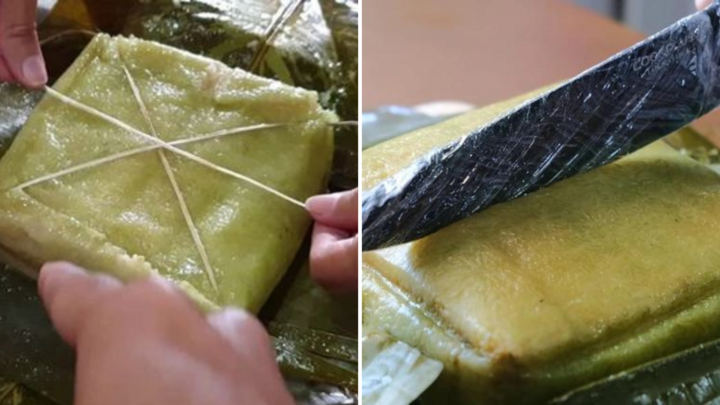There are two common methods to cut the banana leaf strings when unwrapping Banh Chung: using a knife or the traditional method of using the leaf strings themselves. The latter is considered a cultural tradition and showcases one’s dexterity and attention to detail. It also ensures that the sticky rice and fat from the cake don’t cling to the knife, saving cleaning time.
However, this technique requires patience and a steady hand. If you’re not careful and pull the strings in the wrong order, the filling might spill out. For those who prioritize speed and convenience, using a knife to cut Banh Chung is a more popular choice, despite the subsequent knife-cleaning hassle.
Which method is preferable: cutting Banh Chung with a knife or the leaf strings?
Let’s explore the pros and cons of each method and allow you to decide which approach suits your preferences and skills.
Cutting Banh Chung with Leaf Strings
This traditional cutting method is an art form. It showcases your dexterity and patience. Here’s how it’s done:
– Remove the leaf strings and unwrap the Banh Chung, keeping 1-2 sturdy strings intact. Clean and tear these strings into thin strips for cutting.
– Place the unwrapped Banh Chung on a plate. Take four equal-length thin strips and place two of them horizontally and vertically across the center of the cake, creating a plus sign. Then, place the other two strips diagonally, connecting the four corners of the cake, effectively dividing it into eight portions. Remember to keep track of the order in which you place the strings by tying knots at the ends.
– Press the strings gently into the cake, and flip the cake over onto another plate so that the strings are at the bottom. Now, tie the strings from outside to inside in the order you noted earlier to ensure evenly cut portions without the filling spilling out.
– Holding the strings firmly against the cake, gently pull them out.
With these steps, you’ve elegantly cut a Banh Chung into neat portions using leaf strings. It requires patience and precision.

The choice is yours: knife or leaf strings? (Illustration: Pinterest)
Cutting Banh Chung with a Knife
This method appeals to those seeking convenience and speed. While it may not showcase your dexterity, it gets the job done efficiently. Here’s how:
– Prepare a pair of gloves, plastic wrap, and a sharp knife (preferably longer than the Banh Chung; avoid using a small or dull knife).
– Unwrap the Banh Chung and place it on a flat plate.
– Wrap the knife with 2-3 layers of plastic wrap.
– Gently cut the cake horizontally, vertically, or into bite-sized pieces as desired.
With these simple steps, you’ve quickly and efficiently cut the Banh Chung without worrying about the filling spilling out or a messy knife. Simply remove the plastic wrap, and your knife remains clean.
The choice between cutting Banh Chung with a knife or leaf strings depends on your personal preferences and skills. If you find that using a knife yields better results and saves time, there’s no need to feel pressured to adhere to traditional expectations. Choose the method that works best for you.
According to VTC

































